IJCRR - 4(19), October, 2012
Pages: 07-14
Date of Publication: 15-Oct-2012
Print Article
Download XML Download PDF
CMEs RELATED MODERATELY INTENSE GEOMAGNETIC STORMS AND THEIR RELATION WITH SOLAR FEATURES AND SOLAR WIND PLASMA PARAMETERS
Author: S.R.Lahauriya, P.L.Verma, A.P.Mishra
Category: General Sciences
Abstract:We have studied CMEs related moderately intense geomagnetic storms-80nT ? Dst ?-200nT, observed during the period of 1997to2007 with solar features and solar wind plasma parameters. We have found that all the CMEs related moderately intense geomagnetic storms are associated with X- ray solar flares of different categories. The association rates of X class, M class, C class and B class X ray solar flares are 15.51%,31.03%,41.37% and 12.5% respectively. It is also found that majority of the CMEs related moderately geomagnetic storms are associated with radio bursts (81.03%).The association rates of type II and type IV radio bursts have been found 48.93% and 51.06% respectively. Further we have concluded that CMEs related moderately intense geomagnetic storms are closely related to disturbances in solar wind plasma parameters. Positive co-relation has been found between magnitude of CMEs related moderately intense geomagnetic storms and maximum (peak) value of average interplanetary magnetic field of associated JIMF events. Statistically calculated co-relation co-efficient is 0.40 between these two events. Positive co-relation has been found between magnitude of CMEs related moderately intense geomagnetic storms and magnitude of maximum (peak) value of southward component of interplanetary magnetic field of associated JIMFBz events. Statistically calculated co-relation co-efficient is 0.44 between these two events. Positive co-relation has also been found between magnitude of CMEs related moderately intense geomagnetic storms and maximum (peak) value of solar wind plasma velocity. Statistically calculated co-relation co-efficient is 0.28 between these two events.
Keywords: Moderately intense geomagnetic storms, Coronal mass ejections, Solar flares, Solar wind plasma parameters.
Full Text:
INTRODUCTION
Solar energetic features, like solar flares, coronal mass ejections (CMEs) and fast solar wind streams that are accompanied by enormous energy and mass. Impact of these disruptive solar emissions on the earth's magnetosphere leads to several kinds of geomagnetic field variations in the geomagnetic field, which are widely evidenced at all latitudes (Gonzalez and Tsurutani 1987). The estimation of ability to generate different types of geomagnetic field variations in the geomagnetic field by these solar and interplanetary phenomena is one of the most important problems of solar–terrestrial physics. Although general concept on sources of geomagnetic disturbances does not change during many years (Crooker and (Gonzalez et al., 1999; Crooker, 2000). According to numerous observations, compressed streams of solar wind (co- rotating interaction region, CIR, and streams ahead magnetic clouds, MC), and magnetic clouds (ejecta), are geoeffective because they may include long southward Bz component of IMF (Gosling and Pizzo, 1999; Gonzalezet al., 1999; Crooker, 2000; Bothmer, 2004). The recurrent storm activity is due to coronal holes that cause fast solar wind streams (Crooker and Cliver, 1994, Webb et al 1995, Kamide 1998). The non recurrent (sporadic) geomagnetic storms are caused by interplanetary disturbances driven by fast coronal mass ejections (CMEs) (Cane et al. 2000, Cane and Richardson 2003, and Zhao and Webb 2003). Several investigators have studied geomagnetic storms with various solar features, solar wind parameters and inferred that CMEs which are the energetic solar features and associated with active regions are responsible for the most geoeffective solar wind disturbances and, therefore, the largest storms and are well associated with geomagnetic storms (Cane, H. V 2000, St. Cyr 2000, Webb, D. F 2000, Zhao, 2003) .Enhanced solar wind speeds and southward magnetic fields associated with interplanetary shocks and ejecta are known to be important causes of geomagnetic storms Gosling, J. T., 1991, Tsurutani, 1988. Mcallister. A.H and Crooker N. U. 1997 have studied effects of solar and heliospheric phenomena on geomagnetic field. They have concluded that major geomagnetic storms, both recurrent and non recurrent are the result of the combined effects of CMEs and CIRs. Correiaa, E. and De Souza R.V. Correiaa (2005) have presented the identification of solar coronal mass ejection (CME) sources for selected major geomagnetic storms. They have inferred that full halo CMEs originating from active regions associated with X-ray solar flares and propagating in the western hemisphere, cause strong geomagnetic storms. Gopalswamy et al ( 2008) have studied magnetic clouds ,coronal mass ejections and geomagnetic storms and they have found that 86% magnetic clouds are associated with full and partial halo coronal mass ejections .The remaining 14% of magnetic clouds are associated with non-halo CMEs originating from close to the disk center. They have concluded that magnetic clouds associated with partial halo and halo coronal mass ejections are most potential candidates for production of geomagnetic storms . They have further concluded that magnetic clouds associated with non halo CMEs may also cause geomagnetic storms . Verma P.L. et al (2009) have studied geomagnetic storms Dst ≤ - 50nT observed during the period of 1997-2006, with halo and partial halo coronal mass ejections associated with X-ray solar flares of different categories and concluded that halo and partial halo CMEs associated with X ray solar flares are most potential candidates for production of geomagnetic storms. Gopalswamy (2009) has studied the role of halo and partial halo CMEs in producing geomagnetic storms. He has reviewed the results obtained by previous investigators and concluded that the generation of geomagnetic storms rates can be readily explained by the different definition of halo CMEs used by different authors. Partial halos are less energetic and generally originate far from the disk center, so most of them behave similar to the non geoeffective CMEs and hence most of the partial halo CMEs may not produce geomagnetic storms. He has inferred those halos CMEs originating close to the disk center are very much effective in producing geomagnetic storms. Lyatsky 2003 has studied the semiannual variation in both geomagnetic activity indices and raw geomagnetic field data at a large number of geomagnetic observatories and found a dramatic decrease in the relative magnitude of this variation from low to high latitudes. While the semiannual variation in the Dst index at low latitudes is about 3 times, for the midlatitude Ap and Am indices it is only about 20–30%, and the auroral electrojet AE index and polar cap PCN index show a very small or no semiannual variation. Echer, E et al (2004) have analyzed plasma and magnetic field parameter variations across fast forward interplanetary shocks during the last solar cycle minimum 1995 1996, and maximum year 2000 .They have observed that the solar wind velocity and magnetic field strength variation across the shocks are the parameters better correlated with Dst. Y. Liu, et al (2006) have studied geomagnetic storms with coronal mass ejections and associated solar flares and they have concluded that the flare associated CMEs and geomagnetic storms are closely related. R.V. de Souzaa (2005) have present the identification of solar coronal mass ejection (CME) sources for selected major geomagnetic storms (disturbance storm index– Dst≤100 nT). They have inferred that full halo CMEs originating from active regions associated with X-ray solar flares and propagating in the western hemisphere, cause strong geomagnetic storms. Badruddin; Singh, Y. P. (2009) have studied the subset of CMEs, called interplanetary magnetic clouds (MCs), observed in the heliosphere and their associated features (shock/sheath, IR and HSS). Best-fit equations representing the relation between level of the geomagnetic activity and interplanetary plasma/field parameter have been obtained.Zhao, et al (2007) studied the source locations of 130 solar flares associated with type II radio burst events and interplanetary shocks observed by L1 spacecraft during February 1997-August 2002. They have investigated the relative positions between the flare sources, the heliospheric current sheet (HCS), and the Earth. They have found that (1) Solar flares are usually distributed within [S30°, N30°] in heliographic latitude and [S30°, N30°] × [E10°, W30°] are the predominant source region on the solar disk that includes the majority of geoeffective solar flares. In this investigation CMEs related moderately intense geomagnetic storms observed during the period of 1997 2007 have been studied with different energetic solar features and solar wind disturbances interplanetary parameters to know the physical process mainly responsible for CMEs related geomagnetic storms. Experimental Data In this investigation hourly Dst indices of geomagnetic field have been used over the period 1997 to 2007 to determine onset time, maximum depression time, magnitude of geomagnetic storms. This data has been taken from the NSSDC Omni web data system which been created in late 1994 for enhanced access to the near earth solar wind, magnetic field and plasma data of omni data set, which consists of one hour resolution near earth, solar wind magnetic field and plasma data, energetic proton fluxes and geomagnetic and solar activity indices. The data of coronal mass ejections (CMEs) have been taken from SOHO – large angle spectrometric, coronagraph (SOHO / LASCO) and extreme ultraviolet imaging telescope (SOHO/EIT) data. To determine disturbances in interplanetary magnetic, hourly data of average interplanetary magnetic field has been used, these data has also been taken from Omni web data(http;//omniweb.gsfc.nasa.gov/form/dxi.html)) . The data of X ray solar flares radio bursts, and other solar data, solar geophysical data report U.S. Department of commerce, NOAA monthly issue and solar STP data (http://www.ngdc.noaa.gov/stp/solar/solardataserv ices.html.) have been used.
DATA ANALYSIS AND RESULTS
1-CMEs Related Moderately Intense Geomagnetic Storms with X- Ray Solar Flares
From the data analysis we have identified 58 CMEs related moderately intense geomagnetic storms during the period of 1997-2007 and all have been found to be associated with X ray solar flares of different categories. Out of 58 associated moderately intense geomagnetic storms ,09 (15.51%) geomagnetic storms are found to be associated with X class X-ray solar flares,18(31.03%) geomagnetic storms are found to be associated with M class X-ray solar flares ,24 (41.37% ) geomagnetic storms are found to be associated with C class X-ray solar flares and 07 (12.5%) CMEs related moderately intense geomagnetic storms are found to be associated with B class X-ray solar flares.
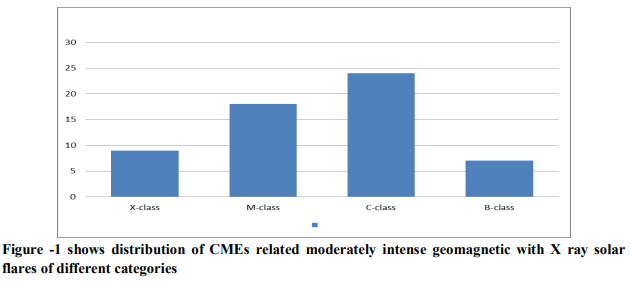
2-CMEs Related Moderately Intense Geomagnetic Storms with Radio Bursts
From the data analysis we have identified 58 CMEs related moderately intense geomagnetic storms during the period of 1997-2007 and majority of the CMEs related moderately intense geomagnetic storms 47(81.03%) have been found to be associated with radio bursts. Out of 47 associated moderately intense geomagnetic storms, 23 (48.93%) geomagnetic storms are found to be associated type II and ,24(51.06%) geomagnetic storms are found to be associated with type IV radio bursts.
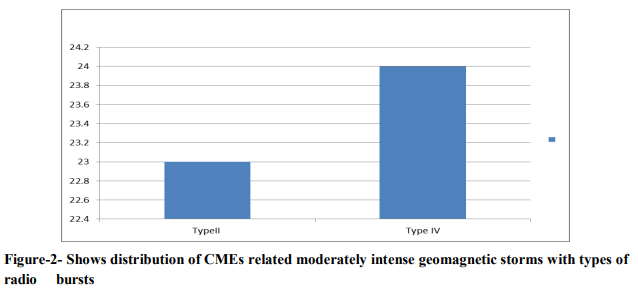
3-CMEs Related Moderately Intense Geomagnetic Storms with Disturbances in Interplanetary Magnetic Field.
From the data analysis of CMEs related moderately intense geomagnetic and associated disturbances in interplanetary magnetic field, we have observed that 57out of 58 CMEs related moderately intense geomagnetic storms are associated with jump in interplanetary magnetic field (JIMF) events. To see how the magnitude of CMEs related moderately intense geomagnetic storms are correlated with the peak value of JIMF events, we have plotted a scatter diagram between the magnitudes of CMEs related moderately intense geomagnetic storms and peak values of associated JIMF events in fig.3.From the fig It is clear that maximum CMEs related moderately intense geomagnetic storms which have large magnitude are associated with such JIMF events which have relatively large magnitude. Positive co-relation has been found between magnitude of CMEs related moderately intense geomagnetic storms and maximum peak value of average interplanetary magnetic field of associated JIMF events. Statistically calculated co-relation coefficient is 0.40 between these two events.
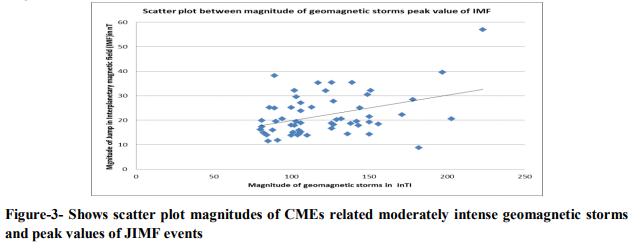
4-CMEs Related Moderately Intense Geomagnetic Storms with Disturbances in Southward Component of Interplanetary Magnetic Field.
From the data analysis of CMEs related moderately intense geomagnetic storms and associated jump in southward component of interplanetary magnetic field (JIMFBz), it is observed that 57 out of 58 CMEs related moderately intense geomagnetic storms are associated with JIMFBz events. Further to see how the magnitude of CMEs related moderately intense geomagnetic storms are correlated with peak value of JIMFBz events, a scatter diagram have been plotted between the magnitudes of CMEs related moderately intense geomagnetic storms and maximum peak values of associated JIMFBz events in fig.4.From the fig it is clear that maximum CMEs related moderately intense geomagnetic storms which have large magnitude are associated with such JIMFBz events which have relatively large peak value. Positive corelation has been found between magnitude of CMEs related moderately intense geomagnetic storms and maximum peak value of average interplanetary magnetic field of associated JIMF events. Statistically calculated co-relation coefficient is 0.44 between these two events.
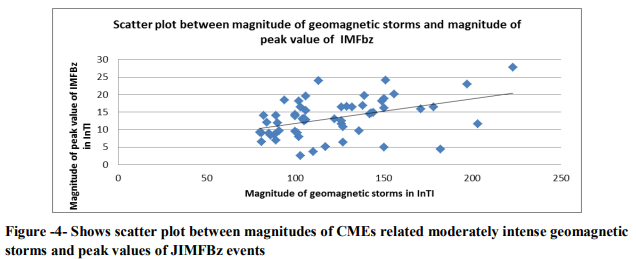
5- CMEs Related Moderately Intense Geomagnetic Storms with Disturbances in solar wind velocity
From the data analysis of CMEs related moderately intense geomagnetic storms and associated jump in solar wind velocity (JSWV), it is observed that 56 out of 58 CMEs related moderately intense geomagnetic storms are associated with JSWV events. Further to see how the magnitude of CMEs related moderately intense geomagnetic storms are correlated with peak value of JSWV events, a scatter diagram have been plotted between the magnitudes of geomagnetic storms and maximum peak values of associated JSWV events in fig. 5 From the fig it is clear that maximum CMEs related moderately intense geomagnetic storms which have large magnitude are associated with such JSWV events which have relatively large peak value. Positive co-relation has been found between magnitude of geomagnetic storms and maximum peak value of jump in solar wind velocity. Statistically calculated co-relation co-efficient is 0.28 between these two events.
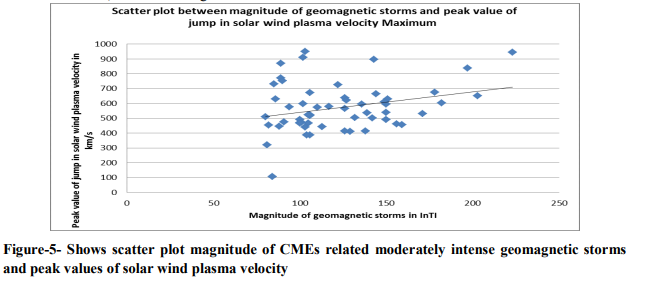
CONCLUSION
From the analysis of CMEs related moderately intense geomagnetic storms with X-ray solar flares, it is concluded that majority of the CMEs related moderately intense geomagnetic storms are found to be associated with X-ray solar flares.
Positive co-relation has been found between magnitude of CMEs related moderately intense geomagnetic storms and maximum (peak) value of average interplanetary magnetic field of associated JIMF events. Statistically calculated co-relation co-efficient is 0.40 between these two events. Positive co-relation has been found between magnitude of CMEs related moderately intense geomagnetic storms and magnitude of maximum (peak) value of average interplanetary magnetic field of associated JIMFBz events. Statistically calculated co-relation co-efficient is 0.44 between these two events. Positive co-relation has been found between magnitude of CMEs related moderately intense geomagnetic storms and peak value of associated jump in solar wind plasma velocity JSWV events. Statistically calculated corelation co-efficient is 0.28 between these two events. From the above results it is concluded that CMEs related moderately intense geomagnetic storms are closely related with X-ray solar flares, disturbances in solar wind plasma parameter, interplanetary magnetic fields and solar wind plasma velocity and play crucial role to explain characteristics of CMEs related moderately intense geomagnetic storms.
ACKNOWLEDGMENT
The authors acknowledge the immense help received from the research scholars and scientists whose articles are cited and included in references of this manuscript. The authors are also grateful to authors/editors/publishers of all those articles, journals and books from where the literature for this article has been reviewed and discussed. The authors would like to thank Prof.B.P.Chandra, Prof.S.K. Nigam and Prof.P.K. Shukla for valuable suggestions.
References:
1. Bothmer, V. IEEE Transactions on Plasma Science 32 (4), 1411, 2004.
2. Badruddin; Singh, Y. P. Planetary and Space Science, 57( 3), 318, 2009.
3. Crooker, N.U. J. Atmos. Sol–Terr. Phys. 62, 1071, 2000.
4. Crooker, N.U., Cliver, E.W. Postmodern view of M-regions. J.Geophys. Res. 99, 23383, 1994.
5. Cane, H. V., Richardson, I. G., and St. Cyr, O. C., Geophys. Res. Lett., 27, 3591, 2000.
6. Cane, H.V. and Richardson, I.G. J. Geophys. Res. 108, 1156, 2003
7. Correiaa, E. R.V. de Souzaa Journal of Atmospheric and Solar-Terrestrial Physics 67, 1705, 2005.
8. Crooker, N.U. J. Atmos. Sol–Terr. Phys. 62, 1071, 2000
9. R.V. de Souzaa (2005) Correiaa, E. R.V. de Souzaa Journal of Atmospheric and SolarTerrestrial Physics 67, 1705, 2005
10. Echer, E M V Alves and W D Gonzalez, Solar Phys. 221, 361,2004.
11. Gonzalez, W.D.Tsurutani, B.T., B.T. Planet Space Sci,.35(.9), 1101, 1987.
12. Gonzalez, W.D., Tsurutani, B.T., Clua de Gonzalez, A.L. Space Sci. Rev. 88, 529, 1999.
13. Gosling, J.T., Pizzo, V.J. SpaceSci. Rev. 89, 21, 1999.
14. Gosling, J. T., McComas, D. J., Phillips, J. L., and Bame, J. J. Geophys. Res.,96, 7831, 1991.
15. Gopalswamy, N., S. Akiyama, S. Yashiro, G. Michalek, and R. P. Lepping, J. Atm. Sol. Terr. Phys., 70, 245, 2008.
16. Gopalswamy N.Letter Earth Planets Space, 61, 1, 2009.
17. Y. Kamide J. Geophys. Res. 103, NO. A8 - 17705, 1998.
18. W. Lyatsky and Tan ,A J.Geophys Vol 108 No 108(A3) 1134 2003.
19. Liu, Y. D. F. Webb, and X. P. Zhao the Astrophysical Journal, 646:1335Y1348, 2006.
20. Mcallister.A.H.and Krooker.N.U Geophysical monograph Vol 99, 303, 279-289, 1997 St. Cyr, O.C. et al. J. Geophys. Res. 105, 18,169–18, 185, 2000.
21. Tsurutani, B T Gonzalez, W D F Tang, S I Akasofu and E J Smith, J. Geophys. Res. 93, 8519, 1988.
22. Verma P.L. Tripathi A.K. and Sharma , Sushil J. Plasma Fusion Res. SERIES,. 8, 221,2009.
23. Webb D.F. Revs. Geophys, 33, 577, 1995 Webb, D. F., Cliver, E. W., Crooker, N. U., St. Cyr, O. C., and Thompson, B. J., J. Geophys. Res., 105, 7491, 2000.
24. Zhao, X. P.; Webb, D. F. J. Geophys. Res. Volume 108, Issue A6, pp. SSH 4-1, 1234, .2003.
25. Zhao, Xinhua; Feng, Xueshang; Wu, ChinChun J. Geophys. Res .Vol.112, ,A6, 2007.
26. Zhao, X. P.; Webb, D. F. J. Geophys. Res. Volume 108, A6, pp. SSH 4-1, 1234, .2003.
|






 This work is licensed under a Creative Commons Attribution-NonCommercial 4.0 International License
This work is licensed under a Creative Commons Attribution-NonCommercial 4.0 International License